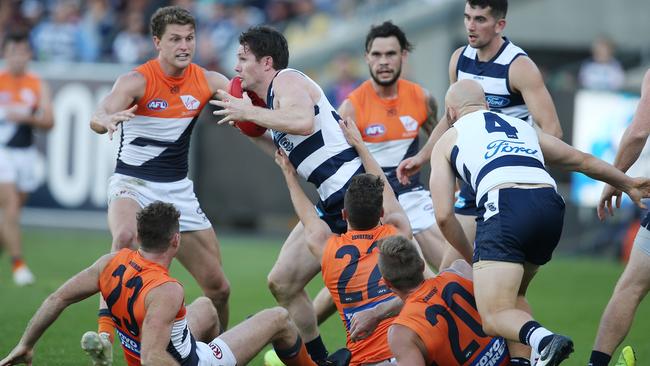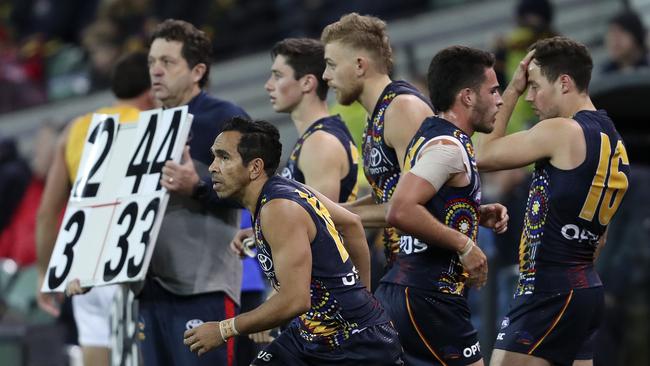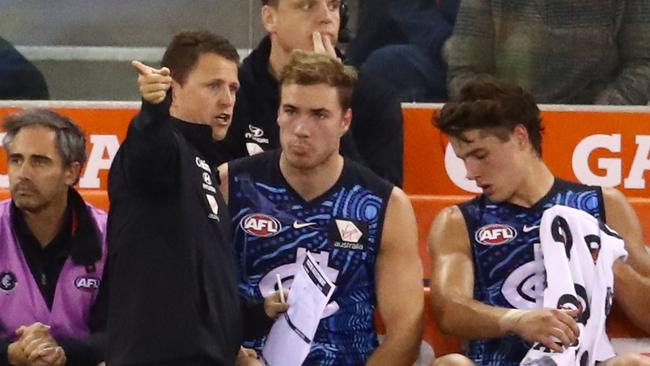Mark Bickley: How interchange cap rules are hurting players and the spectacle of AFL
Despite the AFL’s efforts to open up the game and boost scoring, just one team kicked more than 100 points in Round 10. Mark Bickley argues that instead of introducing rules, the league should remove one.
Mark Bickley
Don't miss out on the headlines from Mark Bickley. Followed categories will be added to My News.
- Tex reveals reason for dodging contest
- Walker slammed for ‘unacceptable’ effort
- ‘We can dig ourselves out again’: Greenwood
- The Moment: $1.5m Crows talent running
- Footy’s biggest coach v media blow-ups
The game was deemed to be in such a dire state last year in regards to congestion and lack of scoring that for the first time rules were introduced to restrict players’ starting positions at centre bounces.
The tradition of kicking the ball back in after a behind from within the goal square was also erased with the stroke of a pen. Both changes aimed at opening up the game and to facilitate greater scoring.
As we approach the halfway mark of the season how have the innovative rule changes gone?
At this stage you would have to say both have failed.
Congestion has not changed, if anything it has risen. Scoring has reduced to the point on the weekend where only one team broke the 100-point barrier and the early figures on the scoring rate from kick-ins has also dropped.
None of this is new information to the astute football lovers who have followed this closely from the start of the year. Most would be aware of the multitude of reasons being put forward as to why.

The evenness of the competition makes some sense with the lower-ranked teams much more competitive than years gone by and, therefore, harder to score against.
Other credible reasoning seems to point to the negative tactics applied by most of the coaches. Pushing extra numbers up around the stoppages, defenders compressing the ground to lock the ball inside forward 50 and risk-averse ball movement, designed to maintain possession rather than taking the game on, are all contributing to stifling the free-flowing continuous nature of the game that fans love and opposition coaches hate.
The improved tackling of players has been given a run as a reason for the congestion, as has the new 6-6-6 rule at the centre bounce.
I want to talk about a longer-term trend I think is contributing to the reduction in scoring and increased congestion and it flies in the face of what many of the experts are saying.
I believe the introduction of the interchange cap in 2016 has started this slippery slide we find ourselves on.

A brief history lesson: The last time four players with uncapped rotations was in play was 2010, with the league average rotations sitting at 118. The next year the sub was introduced, the available rotating players was reduced by one and over the next three years rotations would grow to 133 on average per team. A cap of 120 was introduced for the 2014 season. This would be given two seasons before another change and 2016 would see the sub scrapped and a new interchange cap of 90 introduced. Which is where we sit today.
So with the reduction and capping of interchange we could reasonably expect the game to have prospered in terms of a reduction in congestion, tackling, stoppages and an improvement in disposal efficiency?
Wrong.
They haven’t moved. And the most important of all, scoring, continues in a long-term downward trend.
On what measure can anyone say that it has been successful?
Here is my counter argument: The weekend produced one team out of 18 capable of scoring 100 points.
Of the 180 games teams have participated in up to Round 10, the 100-point barrier has been crossed just 34 times. Compare that to the last time there was a four-man uncapped interchange in 2010 and that number was almost double at 66.

My theory is that as the interchange has been reduced the fatigue level of the players has increased — and here’s where it gets interesting.
Instead of the game opening up and scores rising, teams under fatigue make poor decisions and more mistakes. The skill level drops and the big one is the inability to finish off in front of goal.
Goal-kicking accuracy has been diabolical over the past few years, it’s actually going backwards. The interchange reduction theorists would have us believe that fatigue is good, and that when players get tired the game opens up and the scoring flows.
The numbers just don’t support it. There is no discernible difference between scoring in the first half, compared to scoring in the last half. Which would be the obvious consequence if that theory was correct.
The other problem with fatigue is the increased likelihood of soft tissue and stress-related injuries. A quick perusal of team injury lists has just over 180 names on it. One in five players in the competition is currently injured. This has the two-fold effect of robbing us of the best players showcasing their skills, as well as exposing more of the depth players on AFL lists, again feeding into the drop off in skills during games.

The reduction in interchange doesn’t change the way the game is played it just changes the way the players are prepared and trained. It also impacts on recruiting. Unless you are an elite athlete your chances of succeeding on an AFL list are severely reduced, making it more desirable to draft an athlete and teach him to play football, than a footballer who may not be a great athlete.
Which again may explain the drop off of skills and scoring that we are seeing.
I’m not criticising the AFL for trying to make the game more attractive which is what we all want but to me it’s pretty clear, the interchange cap hasn’t worked.
So instead of adding new rules, let’s remove one. Go back to allowing coaches to do what they want with their interchange bench. The freedom may create some diversity of tactics, it may also see less of our best players out injured and hopefully provide an opportunity for the next Sam Mitchell or Dane Swan who may well be overlooked for a sleeker more athletic type of player seen as more suitable for today’s game.


